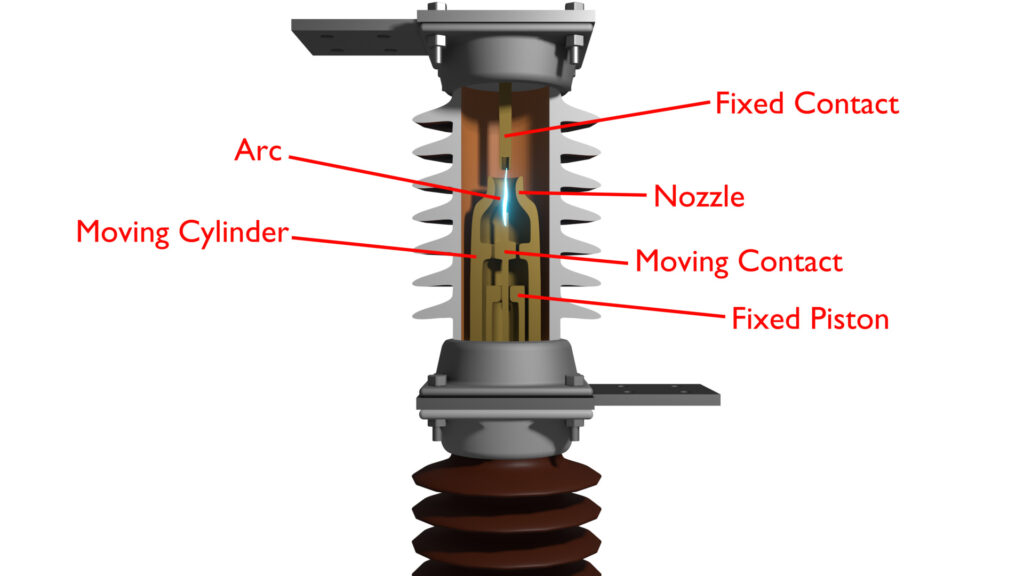In this article, we will focus on the types of SF6 circuit breakers. These are double pressure type SF6 circuit breakers and single pressure type SF6 circuit breakers. The double-pressure-type SF6 circuit breaker is an obsolete technology. Utilities, previously used in substations. Whereas the single pressure type SF6 circuit breaker is the modern design of circuit breakers. We also sometimes call a single pressure type SF6 circuit breaker as a puffer-type circuit breaker.
We will discuss here the basic construction, the working principle of both the types of SF6 circuit breakers. Which means how they extinguish arcs. Then, we will focus on why a single pressure type design offers advantages over the double pressure type design. Why the double pressure type circuit breaker become obsolete nowadays?
Double Pressure Type SF6 Circuit Breaker and How it works
The double pressure type SF6 circuit breaker was one pioneer design. Obviously, it utilizes sulfur hexafluoride gas as the arc quenching medium. This is an improved version of the air blast circuit breaker. These breakers operate with two distinct pressure levels of SF6 gas. The concept somewhat similar to the air blast circuit breaker.
Principle of Air Blast Circuit Breaker
In an air blast circuit breaker, when the CB contacts open, dry and compressed air strikes the arc. A high-pressure chamber keeps the air. At the time of CB operation, a valve opens and the air comes out with a high force through a nozzle. This cools down the arc and thereby quenches the arc.
Principle of Double Pressure SF6 Circuit Breaker
A double pressure type SF6 circuit breaker works on the same principle. Here, the high-pressure chamber or reservoir stores SF6 gas instead of SF6 gas. The SF6 gas inside the high-pressure chamber remains at a pressure around 20 to 25 kg per square centimeter.
There is also SF6 gas in the interrupting chamber. But here the pressure is much lower than that of the high-pressure chamber. The pressure of SF6 gas in the interruption chamber is about 6 to 7 kg per centimeter square. During the opening of contacts in live conditions, naturally, an arc forms in the contact gap. At the same time, the valve associated with the high pressure chamber will open and release the gas towards the arc through a specially designed nozzle. Hence, the forceful jet of SF6 gas performs two main actions.
High Electronegativity SF6 Gas
One, due to the high electronegativity, SF6 gas absorbs free electrons from the arc plasma. That means, it reduces the free movable electrons in the arc plasma. Hence, it reduces the intensity of the arc.
Cooling Effect of SF6 Gas
Next, SF6 gas is a very good absorber of heat. So, it extracts heat from the arc and takes it away. Because SF6 gas flows from the nozzle through the arc at high speed. As it removes heat from the arc, the temperature of the arc reduces. Therefore, it reduces the diameter of the arc. As a result, after a few current zeros of the current waveform, the arc finally extinguishes. Hence, the current becomes interrupted. After the completion of the operation, a compressor starts to collect the released gas from the interruption chamber. That means the compressor sucks back the gas to the high-pressure chamber. Lastly, the breaker gets ready for the next operation.

We have seen that the operating procedure of the double-pressure-type SF6 circuit breaker is similar to the air blast circuit breaker. The main difference is that the air blast circuit breaker releases air into the atmosphere. In contrast, the SF6 circuit breaker does not release SF6 gas into the atmosphere. Instead, it recollects the SF₆ for the next operation.
Advantages and Disadvantages of Double Pressure Type SF6 CB
These designs offer excellent arc-quenching capabilities because of the high-speed jet of SF6 gas on the arc plasma. Obviously, the dielectric strength, cooling capability, and electronegativity, all three things are superior in SF6 gas. So, SF6 gas offers more efficient arc quenching than air. That is why the double pressure type SF6 circuit breaker is suitable for interrupting high short-circuit fault currents.
Drawbacks
However, it has some drawbacks. The double pressure type SF6 circuit breaker requires many components. These are gas compressors, gas reservoirs, gas pumps, associated motors, and piping system pressure gauges. To accommodate all these things together, the circuit breakers become bulky and mechanically complex. It is also prone to gas leakage because of its complex SF6 gas network and piping system. These circuit breaker demands more maintenance, cost, and operational challenges compared to modern types of SF6 circuit breakers.
Why did double pressure type SF6 CBs become obsolete?
After the development of modern single pressure type SF6 circuit breakers, these have become obsolete. Because, single pressure type SF6 circuit breakers are much simpler, lighter, and compact in size. Also, we call this type of circuit breaker a self-blast type, or puffer type SF6 circuit breaker. The foremost advantage of this type of modern circuit breaker is that it is much cheaper than the double pressure type SF6 circuit breaker. Therefore, single-pressure SF6 CB starts dominating the market. Historically, the double-pressure-type SF6 circuit breaker played a vital role in ultra-high-voltage applications, but its large footprint has made it obsolete.
Single Pressure Type SF6 Circuit Breaker and How it Works
The technology of the single-pressure type SF6 circuit breaker is very simple. It does not utilize two separate gas compartments, such as a high-pressure and a low-pressure chamber. Instead, it uses only a single-pressure container, which serves as the interrupting chamber. The moving contact and fixed contact are typically designed in this type of circuit breaker. When the moving contact moves, it compresses and releases SF6 gas through its nozzle-like opening. Actually, it does not require any additional mechanism to compress the gas. The contact assembly comprises the fixed contact and piston. These are the stationary parts of the contact mechanism.

Working Principle of Puffer Type SF6 Circuit Breaker
A cylinder attached to the moving contact constitutes the moving part of the mechanism. The top portion of the cylinder is shaped to function as a nozzle. When the circuit breaker opens, the moving contact starts moving backward from the fixed contact. Hence, it reduces the volumetric space inside the moving cylinder above the fixed piston. Therefore, this movement compresses the SF6 gas in that space. Hence, the gas releases along the axis of the arc through the specially designed nozzle-like cylinder top. Therefore, it cools down the arc. Additionally, due to the high electronegativity, the flowing SF6 gas absorbs the electrons in the arc plasma. Hence, it extinguishes the arc after just a few zero crossings of the current.
So, we can understand that for arc quenching, a puffer type SF6 circuit breaker adopts a similar mechanism like the double-pressure-type SF6 circuit breaker. The only difference is that, in this case, it uses a single pressurized chamber, which is the interruption chamber. Here, the mechanical movement of the moving contact compresses the gas. So, it does not require any additional arrangement to compress the gas. In contrast, the double-pressure-type SF6 circuit breaker uses an additional compressor and a high-pressure reservoir for this purpose.
